Spatial-Temporal Pattern and Influencing Factors of Land Ecological Carrying Capacity in The National Pilot Zones for Ecological Conservation in China
Abstract
1. Introduction
2. Materials and Methods
2.1. Study Area
2.2. Index System and Data Sources
2.3. Methods
2.3.1. Improved Ecological Footprint Model
2.3.2. Time Series Analysis Methods
2.3.3. Geodetector
- (1)
- Urbanization level. Population urbanization is the core of urbanization, and land urbanization is the carrier of urbanization. The development of population urbanization has greatly increased the land urbanization level. The ratio of urban resident population to resident population in the area was selected to characterize the urbanization level.
- (2)
- Population density. Population density reflects the degree of spatial concentration of regional population; a too high spatial concentration of population exerts great pressure on land ecology. The ratio of resident population to administrative area was selected to characterize population density.
- (3)
- Regional gross domestic product. The regional gross domestic product reflects the level of regional economic development; the higher the level of economic development, the more evident is its influence on land use.
- (4)
- Total retail sales of social consumer goods. Total retail sales of consumer goods is the most direct data showing domestic consumption demand, and many consumer goods are directly or indirectly provided by land.
- (5)
- Industrial structure. Numerous high-pollution and high-consumption industries exist in the secondary industry, and these industries have a great impact on the land ecological environment. The ratio of the value added of secondary industry to regional gross domestic product was selected to characterize the industrial structure.
- (6)
- Investment intensity. Part of the fixed asset investment occupies or pollutes the land, and the land itself can be used as fixed assets for investment. The ratio of fixed assets investment to regional gross domestic product was selected to characterize the investment intensity.
- (7)
- Arable land utilization rate. The higher the degree of arable land utilization, the greater the possible impact to the ecology of arable land resources. The ratio of food production to arable land area was selected to characterize the arable land utilization rate.
- (8)
- Forest land coverage. Forest land has the functions of soil and water conservation, wind breaking, and sand fixing, etc. and has a good protection effect on land resources. The ratio of forest land area to administrative area was selected to characterize the degree of forest land coverage.
3. Results
3.1. Temporal Dynamic Evolution Characteristics
3.1.1. Evolutionary Characteristics of Ecological Footprint
3.1.2. Evolution Characteristics of Biocapacity
3.1.3. Evolutionary Characteristics of Natural Capital
3.2. Spatial Evolution Characteristics
3.3. LECC Influencing Factors
4. Discussion
4.1. Result Analysis
4.2. Policy Recommendations
- (1)
- Strengthening land ecological management and optimizing the practice of land use. Local government departments should focus on strengthening the ecological management of arable land, forest land, and grassland; conduct ecological evaluation and grading; and conduct fine land ecological restoration and protection activities accordingly. Moreover, they should actively adjust the practice of land use, pay more attention to the use of natural capital flows, improve the level of use of natural capital flows, and gradually reduce the consumption of natural capital stock.
- (2)
- A security warning system should be established to protect the land ecological security. The development intensity should be controlled according to the main function orientation, with a focus on the land ecological protection in very insecure and extremely insecure areas. GIS, RS, GPS, drones, and other modern technical means should be used synthetically to obtain ecological alert data for various types of land. On this basis, real-time monitoring and early warning systems for land ecological security should be established, land ecological security risk information should be reported on a timely basis, and targeted measures should be developed to solve different problems that arise in different parcels of land.
- (3)
- Capturing the key influencing factor and enhancing positive interactions between them. On the one hand, on the basis of ensuring the quality and quantity of existing forest land, unused land could be converted into forest land through afforestation and other measures to increase forest land coverage. On the other hand, the spatial distribution pattern of population could be optimized by adjusting the industrial layout and improving road traffic to alleviate the excessive regional spatial concentration of population. At the same time, by optimizing the industrial structure and reasonably controlling the arable land utilization rate, the positive interactions of forest land coverage and population density in support of LECC will be enhanced.
- (4)
- The experience of model construction should be promoted to stimulate other regions’ LECC to reach a high level. The construction of land ecological civilization has been effective for Guizhou. On the one hand, full play should be continuously given to the measures to improve the LECC further. On the other hand, full play should be given to the role of a model to guide other regions to transform and upgrade their industrial structures and promote economic green development, while strengthening key ecosystem service functions, completing the spatial integration and optimization of forest land, grassland, waters, and agricultural production space, and stimulating other regions’ LECC to improve steadily.
4.3. Limitations and Future Directions of This Study
5. Conclusions
- (1)
- In terms of temporal evolution, the overall land ecological carrying status of each province tends to improve but also shows remarkable interprovincial differences in development trends; the overall performance of Guizhou is better than Jiangxi and Fujian. Focusing on protecting arable land, forest land, and grassland and reducing the consumption of natural capital stock are key to maintaining LECC.
- (2)
- In terms of spatial evolution, the situation of land ecological security in most prefecture-level cities is more severe, and the spatial differentiation of land ecological security patterns is more evident. However, the land ecological pressure index is decreasing, and ecological security is being enhanced. In the long term, actively working on land ecological construction in very insecure, and extremely insecure areas can help optimize the overall land ecological security patterns in the region.
- (3)
- In terms of influencing factors, forest land coverage and population density have the strongest explanatory power for LECC. The interactions of population density with industrial structure and arable land utilization and that of forest land coverage with arable land utilization rate and industrial structure have significant enhancing effects on the interpretation of LECC. Paying attention to the main influencing factors and strengthening their positive interactions are key to improving LECC.
Author Contributions
Funding
Institutional Review Board Statement
Informed Consent Statement
Data Availability Statement
Conflicts of Interest
References
- The State Forestry Administration of China. A Bulletin of Status Quo of Desertification and Sandification in China. 2015. Available online: http://www.forestry.gov.cn/main/65/content-835177.html (accessed on 16 November 2022).
- Qu, X.Q.; Liu, M.; Li, C.L.; Hu, Y.M.; Yin, H.Y.; Qi, L. Review of the research on ecological carrying capacity evaluation methods. J. Meteorol. Environ. 2019, 35, 113–119. [Google Scholar]
- Park, R.E.; Burgess, E.W. Introduction to the Science of Sociology; University of Chicago Press: Chicago, IL, USA, 1921. [Google Scholar]
- Hadwen, S.; Palmer, L.J. Reindeer in Alaska; US Department of Agriculture: Washington, DC, USA, 1922. [Google Scholar]
- Seidl, I.; Tisdell, C.A. Carrying capacity reconsidered: From Malthus’ population theory to cultural carrying capacity. Ecol. Econ. 1999, 31, 395–408. [Google Scholar]
- Clarke, A.L. Assessing the carrying capacity of the Florida Keys. Popul. Environ. 2002, 23, 405–418. [Google Scholar]
- Daneshvar, M.R.M.; Khatami, F.; Zahed, F. Ecological carrying capacity of public green spaces as a sustainability index of urban population: A case study of Mashhad city in Iran. Model. Earth Syst. Environ. 2017, 3, 1161–1170. [Google Scholar]
- Wang, S.; Hu, Z.H. Effect of regional ecological carrying capacity on economic transformation. J. Cent. South Univ. 2017, 24, 1522–1528. [Google Scholar]
- Fang, Y.P.; Zhu, F.B.; Yi, S.H.; Qiu, X.P.; Ding, Y.J. Ecological carrying capacity of alpine grassland in the Qinghai-Tibet Plateau based on the structural dynamics method. Environ. Dev. Sustain. 2021, 23, 12550–12578. [Google Scholar]
- Xiang, X.R.; Pan, T.; Wu, S.H.; Liu, W.D.; Ma, L.; Wang, X.F.; Yin, Y.H.; Li, J. Assessment and Prediction of Ecological Carrying Capacity for the Northern Slope Economic Belt of Tianshan Mountains. Geogr. Res. 2016, 35, 875–884. [Google Scholar]
- Ding, Y.; Peng, J. Impacts of Urbanization of Mountainous Areas on Resources and Environment: Based on Ecological Footprint Model. Sustainability 2018, 10, 765. [Google Scholar]
- Peng, B.H.; Li, Y.; Elahi, E.; Wei, G. Dynamic evolution of ecological carrying capacity based on the ecological footprint theory: A case study of Jiangsu province. Ecol. Indic. 2019, 99, 19–26. [Google Scholar]
- Cuadra, M.; Björklund, J. Assessment of economic and ecological carrying capacity of agricultural crops in Nicaragua. Ecol. Indic. 2007, 7, 133–149. [Google Scholar]
- Salemi, M.; Jozi, S.A.; Malmasi, S.; Rezaian, S. A New Model of Ecological Carrying Capacity for Developing Ecotourism in the Protected Area of the North Karkheh, Iran. J. Indian Soc. Remote Sens. 2019, 47, 1937–1947. [Google Scholar]
- Cheng, C.; Liu, Y.L.; Chen, Y.Y.; Liu, Y.F.; Zhang, Y.; Shen, S.S.; Yang, R.F.; Xu, Z.B.; Hong, Y.S. Diagnosing cropland′s allowable range and spatial allocation in China′s typical mountainous plateau area: An evaluation framework based on ecological carrying capacity. Sci. Total Environ. 2019, 685, 1255–1268. [Google Scholar]
- Wackernagel, M.; Rees, W.E. Perceptual and structural barriers to investing in natural capital: Economics from an ecological footprint perspective. Ecol. Econ. 1997, 20, 3–24. [Google Scholar]
- Niccolucci, V.; Tiezzi, E.; Pulselli, F.M.; Capineri, C. Biocapacity vs. Ecological Footprint of world regions: A geopolitical interpretation. Ecol. Indic. 2012, 16, 23–30. [Google Scholar]
- Xu, B.C.; Pan, J.H. Estimation of potential ecological carrying capacity in China. Environ. Sci. Pollut. Res. 2020, 27, 18044–18063. [Google Scholar]
- Wenpeng, D.; Huimin, Y.; Zhiming, F.; Yanzhao, Y. Assessing the Ecological Carrying Capacity of Countries along the Belt and Road. J. Resour. Ecol. 2022, 13, 338–346. [Google Scholar]
- Peng, B.H.; Wang, Y.Y.; Elahi, E.; Wei, G. Evaluation and Prediction of the Ecological Footprint and Ecological Carrying Capacity for Yangtze River Urban Agglomeration Based on the Grey Model. Int. J. Environ. Res. Public Health 2018, 15, 2543. [Google Scholar]
- Lu, Y.; Li, X.S.; Ni, H.; Chen, X.; Xia, C.Y.; Jiang, D.M.; Fan, H.P. Temporal-Spatial Evolution of the Urban Ecological Footprint Based on Net Primary Productivity: A Case Study of Xuzhou Central Area, China. Sustainability 2019, 11, 199. [Google Scholar]
- Liu, Y.; Qu, Y.; Cang, Y.D.; Ding, X.A. Ecological security assessment for megacities in the Yangtze River basin: Applying improved emergy-ecological footprint and DEA-SBM model. Ecol. Indic. 2022, 134, 108481. [Google Scholar]
- Zhu, Z.Y.; Mei, Z.K.; Li, S.L.; Ren, G.X.; Feng, Y.Z. Evaluation of Ecological Carrying Capacity and Identification of Its Influencing Factors Based on Remote Sensing and Geographic Information System: A Case Study of the Yellow River Basin in Shaanxi. Land 2022, 11, 1080. [Google Scholar]
- Wang, J.; Zhang, Q.M.; Zou, C.J.; Wang, J.X.; Li, Y.S.; Wang, M.C. Dynamic evolutions of ecological carrying capacity in poor areas using ecological footprint model at Ruyang County of China. Int. J. Agric. Biol. Eng. 2017, 10, 140–150. [Google Scholar]
- He, Y.F.; Xie, H.L. Exploring the spatiotemporal changes of ecological carrying capacity for regional sustainable development based on GIS: A case study of Nanchang City. Technol. Forecast. Soc. Change 2019, 148, 119720. [Google Scholar]
- Wang, S.; Xu, L.; Yang, F.; Wang, H. Assessment of water ecological carrying capacity under the two policies in Tieling City on the basis of the integrated system dynamics model. Sci. Total Environ. 2014, 472, 1070–1081. [Google Scholar]
- Ying, H.; Chen, S.; Mao, Y.Q. Research on Marine Ecological Carrying Capacity of Ningbo City in China Based on System Dynamics. Sustainability 2022, 14, 4568. [Google Scholar]
- Wu, X.L.; Hu, F. Analysis of ecological carrying capacity using a fuzzy comprehensive evaluation method. Ecol. Indic. 2020, 113, 106243. [Google Scholar]
- Wang, M. Calculation of sensitive factors in ecologically sensitive areas of plateau: Comprehensive evaluation of ecological carrying capacity. Appl. Nanosci. 2021, 11, 1–12. [Google Scholar]
- Chen, H.F.; Huang, S.C. Where There Are Lucid Waters and Lush Mountains, There Are Invaluable Assets: Based on Fujian, Jiangxi and Guizhou Evidence of the National Ecological Civilization Pilot Zone. Ecol. Econ. 2022, 38, 204–212. [Google Scholar]
- Rees, W.E. Ecological footprints and appropriated carrying capacity: What urban economics leaves out. Environ. Urban. 1992, 121, 120–130. [Google Scholar]
- Su, Z.L.; Yuan, G.H.; Zhou, W. Evaluation of Land Carrying Capacity in Anhui Province Based on Revised Three-Dimensional Ecological Footprint Model. Res. Soil Water Conserv. 2020, 27, 256–262. [Google Scholar]
- Liu, M.C.; Li, W.H. Calculation of Equivalence Factor Used in Ecological Footprint for China and Its Provinces Based on Net Primary Production. J. Ecol. Rural. Environ. 2010, 26, 401–406. [Google Scholar]
- Liu, M.C.; Li, W.H.; Xie, G.D. Estimation of China ecological footprint production coefficient based on net primary productivity. China J. Ecol. 2010, 29, 592–597. [Google Scholar]
- Xie, H.Y.; Ye, H.S. The update computation for global average yield of main agricultural products in China. J. Guangzhou Univ. Nat. Sci. Ed. 2008, 07, 76–80. [Google Scholar]
- Wang, J.L.; Wen, X.H. Modern Environmental Biotechnology; Tsinghua University Press: Beijing, China, 2001. [Google Scholar]
- Cui, F. Research on Land Use Change and the Ecological Environment Response in the Urban Fringe. Ph.D. Thesis, Nanjing Agricultural University, Nanjing, China, 2013. [Google Scholar]
- Yang, Y.; Hu, D. Dynamic Changes and Driving Factors of Three Dimensional Ecological Footprint in Yulin. J. Nat. Resour. 2018, 33, 1204–1217. [Google Scholar]
- Fang, K. Assessing the natural capital use of eleven nations: An application of a revised three-dimensional model of ecological footprint. Acta Ecol. Sin. 2015, 35, 3766–3777. [Google Scholar]
- Sen, P.K. Estimates of the Regression Coefficient Based on Kendall′s Tau. J. Am. Stat. Assoc. 1968, 63, 1379–1389. [Google Scholar] [CrossRef]
- Mann, H.B. Nonparametric Tests Against Trend. Econometrica 1945, 13, 245–259. [Google Scholar] [CrossRef]
- Achite, M.; Caloiero, T.; Toubal, A.K. Rainfall and Runoff Trend Analysis in the Wadi Mina Basin (Northern Algeria) Using Non-Parametric Tests and the ITA Method. Sustainability 2022, 14, 9892. [Google Scholar] [CrossRef]
- Xu, D.; Lin, W.P.; Shi, R.H.; Gao, J.; Li, L.B. Spatial-temporal evolution patterns of PM2.5 exposure risk in the Yangtze River Delta Ecological Greening Development Demonstration Area during 2001–2020. Acta Sci. Circumstantiae 2022, 42, 36–51. [Google Scholar] [CrossRef]
- Wang, J.F.; Xu, C.D. Geodetector: Principle and prospective. Acta Geogr. Sin. 2017, 72, 116–134. [Google Scholar]
- Wu, Q.; Cao, Y.; Fang, X.; Wang, J.; Li, G. A systematic coupling analysis framework and multi-stage interaction mechanism between urban land use efficiency and ecological carrying capacity. Sci. Total Environ. 2022, 853, 158444. [Google Scholar]
- Xiao, Y.; Huang, H.; Deng, X.H. Research on Regional Ecological Carrying Capacity from the Ecological Civilization Construction Perspective: Taking Cheng-Yu City Group as an Example. Ecol. Econ. 2018, 34, 179–183+208. [Google Scholar]
- Feng, Y.Q.; Zhang, H.L. Has Fintech Promoted Innovation Performance? Foreign Econ. Manag. 2021, 43, 50–67. [Google Scholar] [CrossRef]
- Li, J.; Zhang, H.; Sun, Z. Spatiotemporal variations of land urbanization and socioeconomic benefits in a typical sample zone: A case study of the Beijing-Hangzhou Grand Canal. Appl. Geogr. 2020, 117, 102187. [Google Scholar]
- Bryson, J.R.; Mulhall, R.A.; Song, M.; Kenny, R. Urban assets and the financialisation fix: Land tenure, renewal and path dependency in the city of Birmingham. Camb. J. Reg. Econ. Soc. 2017, 10, 455–469. [Google Scholar] [CrossRef]
- Huang, Z.L. On the Road of China’s Economic Development in the Stage of High-quality Development. China Econ. Stud. 2021, 63, 5–16. [Google Scholar] [CrossRef]
- Ji, Z.H.; Zhang, P. Spatial Difference and Driving Mechanism of Urban Land Use Efficiency Under the Environmental Constraints: Based on 285 Cities in China. China Land Sci. 2020, 34, 72–79. [Google Scholar]
- Ke, S.G.; Cui, H.Y.; Lu, X.H.; Hou, J.; Wu, Y.Q. Research on the Spatial-Temporal Pattern and Mechanisms of Green Transition of Farmland Use: A Case of Hubei Province. China Land Sci. 2021, 35, 64–74. [Google Scholar]
- Yang, Y.; Zhu, Y.Z.; Zhang, J.Q. Driving factors of the ecological footprint of the Guanzhong-Tianshui Economic Zone. Acta Ecol. Sin. 2017, 37, 7061–7067. [Google Scholar]
- Chen, X.J.; Wang, J.; Kong, X.S.; Li, Z.H. Spatiotemporal differences of ecological footprints and synergistic relationship to economic development in Wuhan urban agglomeration. Chin. J. Ecol. 2020, 39, 3452–3462. [Google Scholar] [CrossRef]
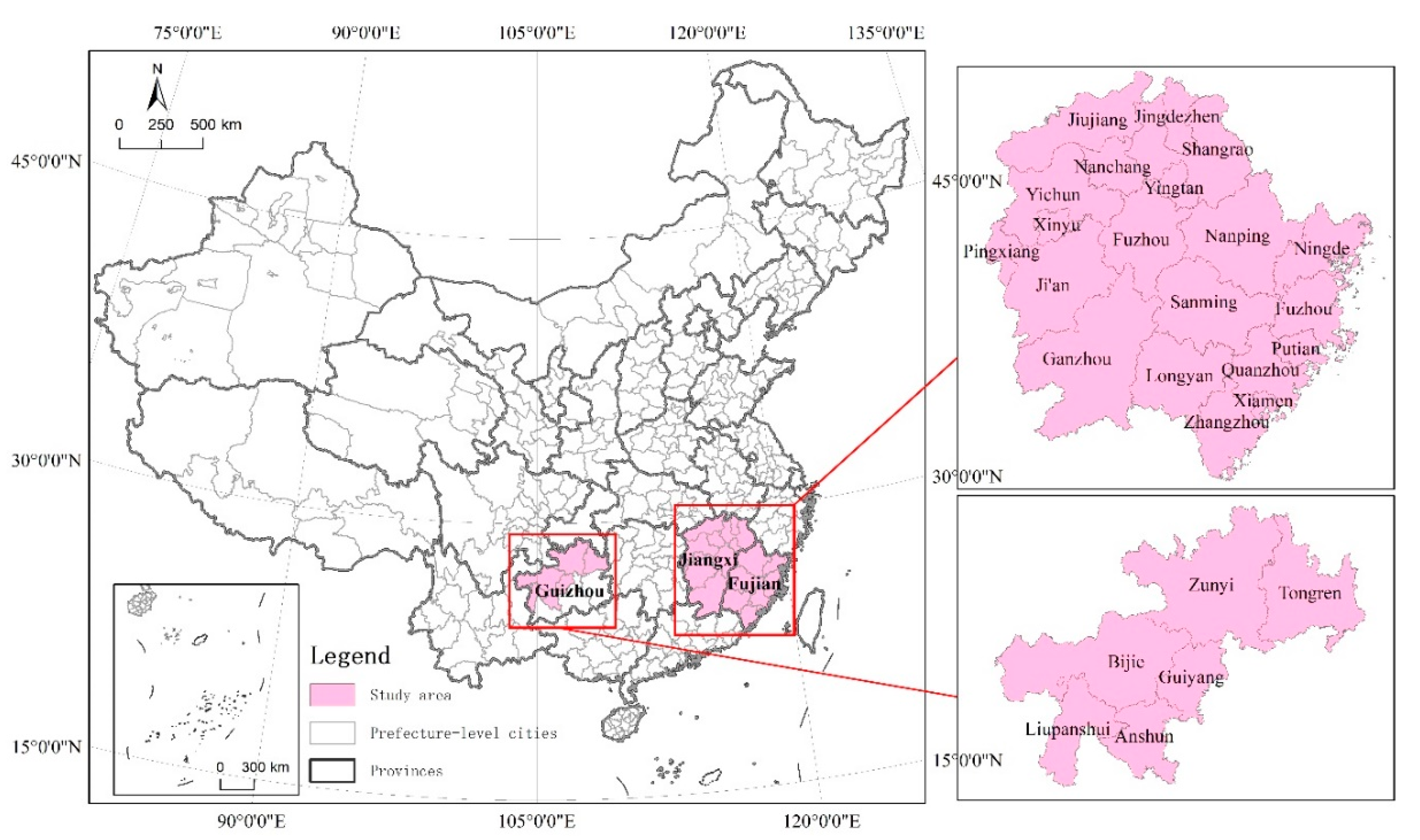
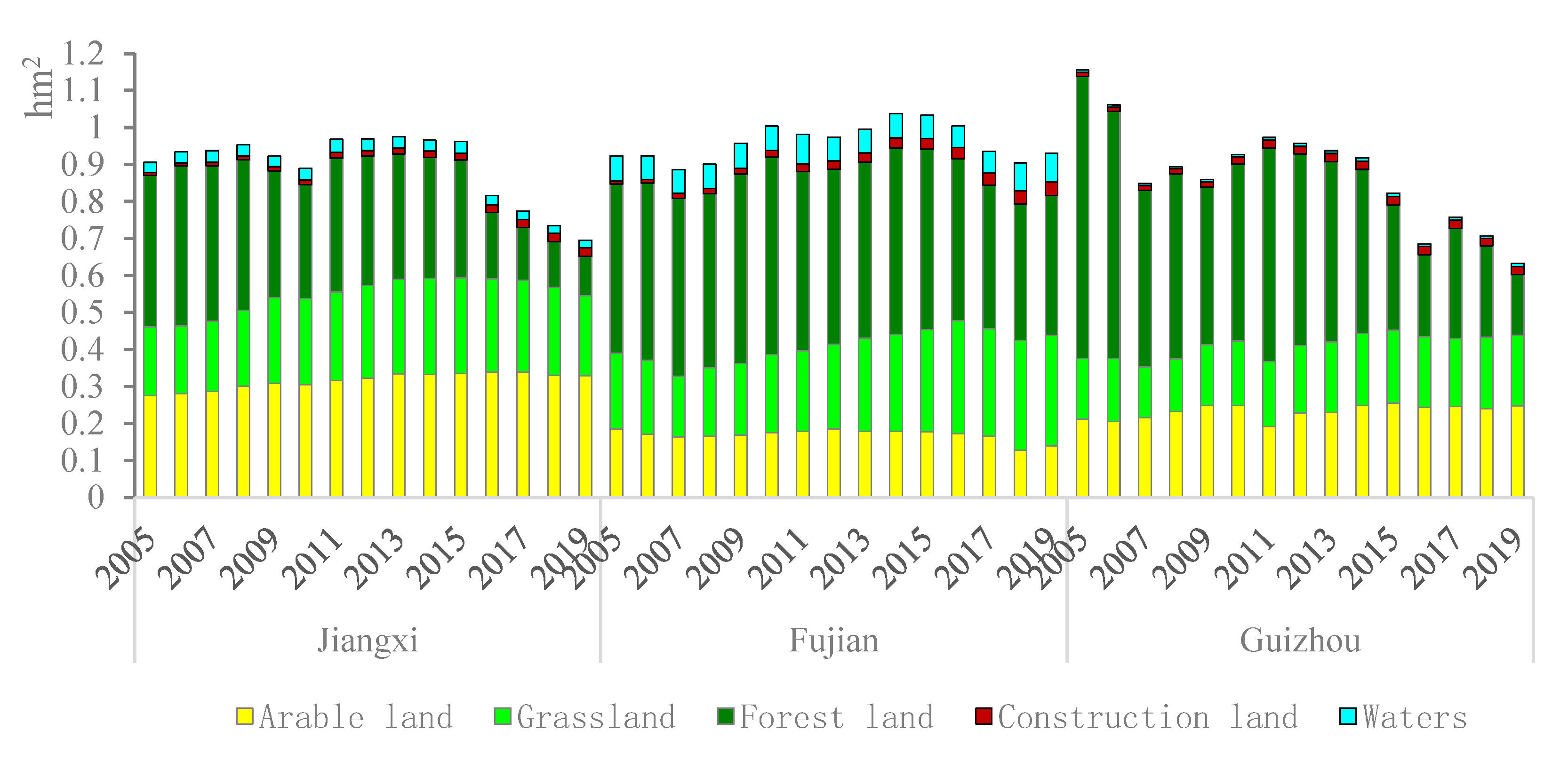
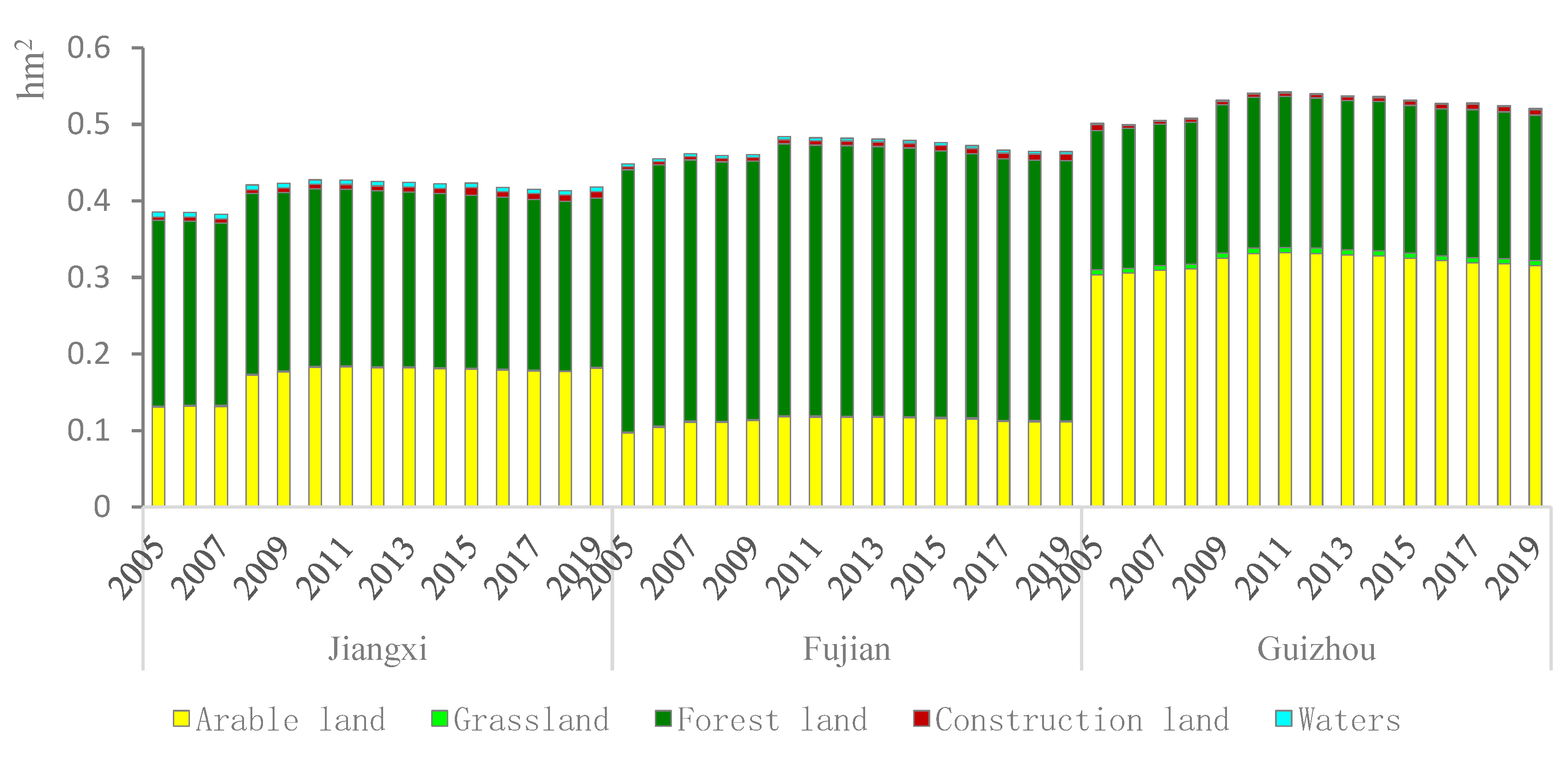
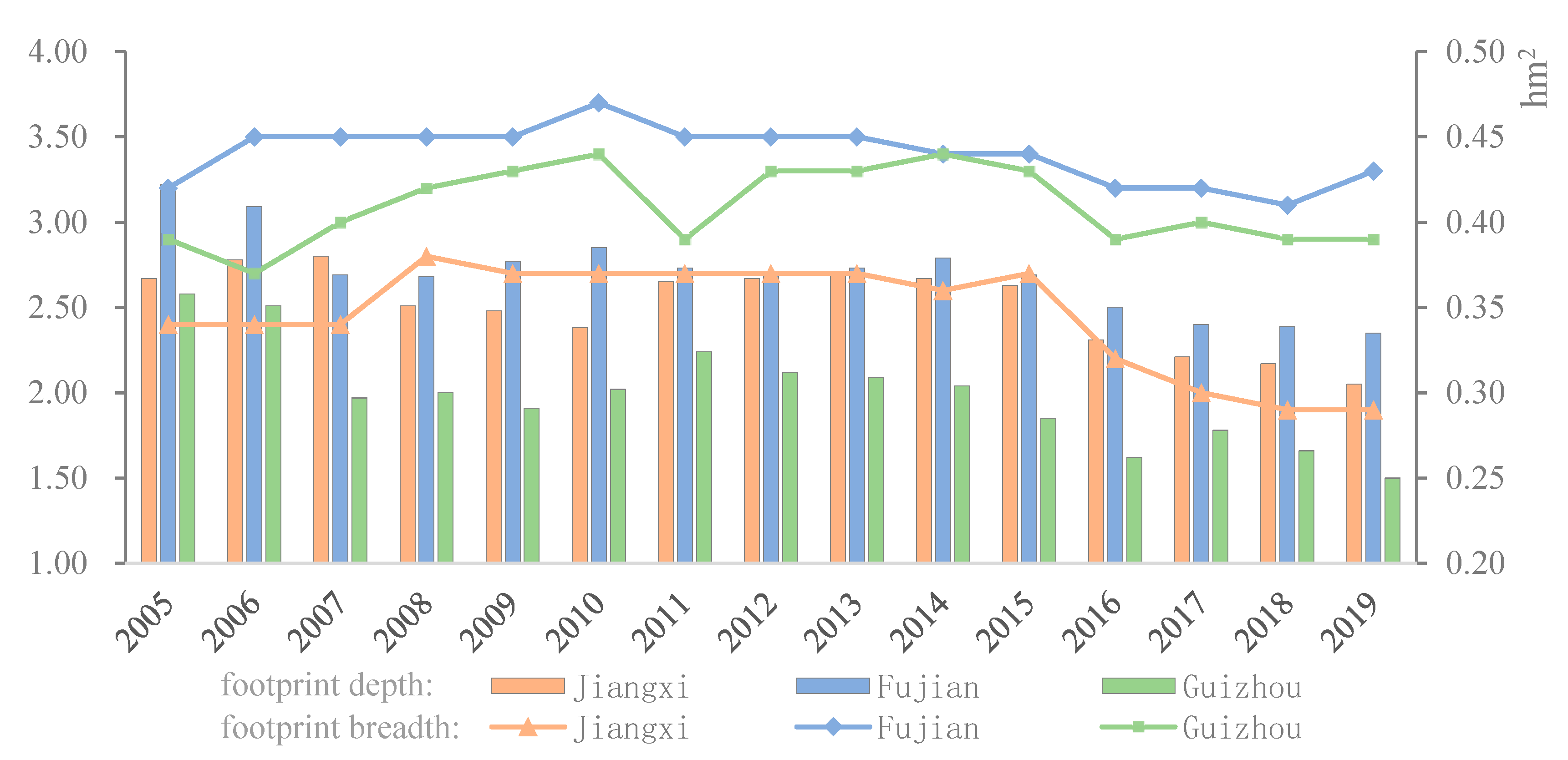
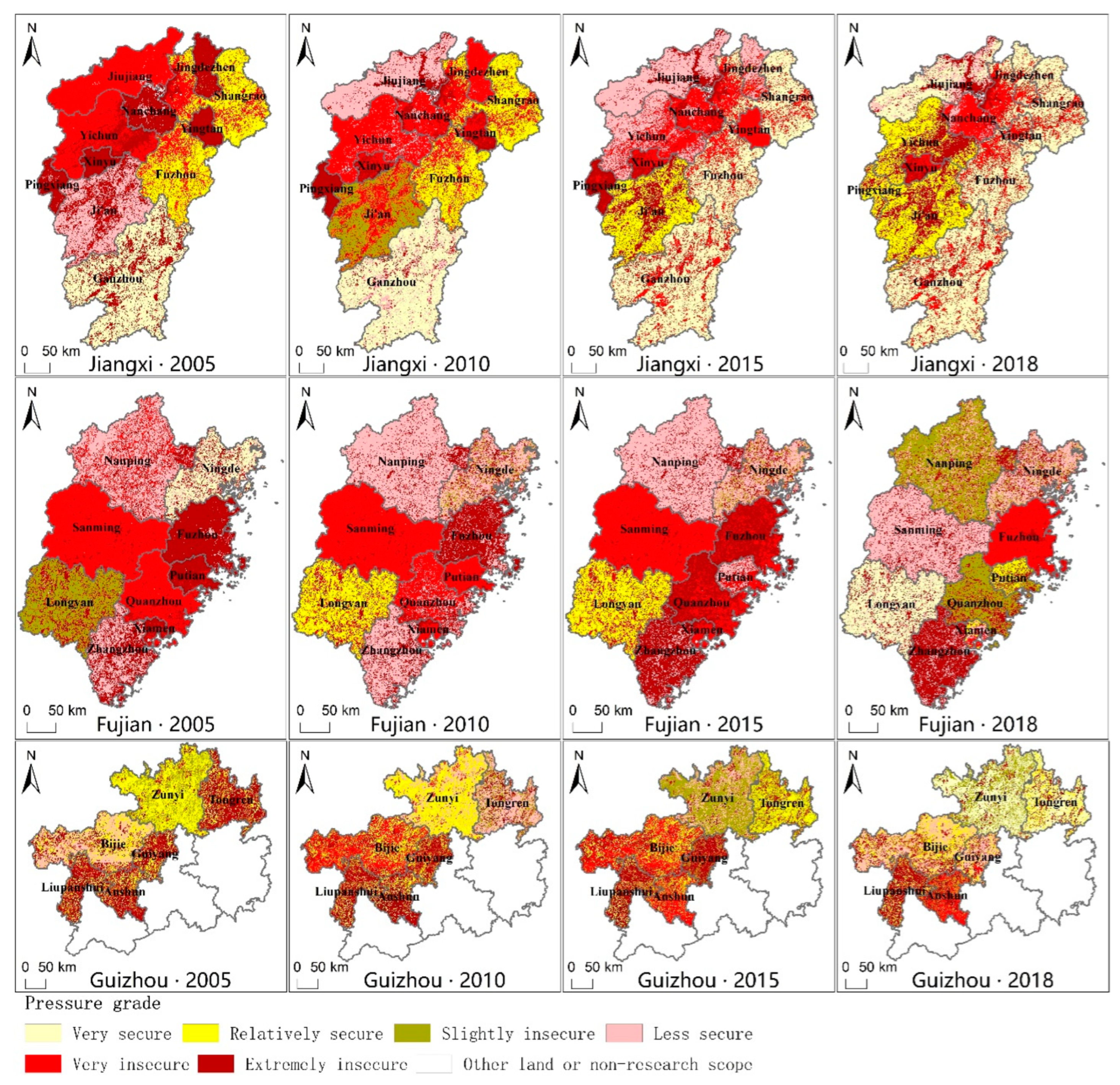
| Type of Account | Evaluation Indicators | Type of Land |
|---|---|---|
| Biological resources account | Grain, Oilseeds, Vegetables, Cotton, Sugarcane, Tobacco | Arable land |
| Meat, Milk, Poultry and Eggs | Grassland | |
| Tea, Wood, Fruit | Forest land | |
| Aquatic products | Waters | |
| Construction land account | Total electricity consumption | Construction land |
| Pollution account | Industrial solid wastes | Arable land |
| Industrial sulfur dioxide, Industrial dust | Forest land | |
| Industrial wastewater | Waters |
| Index Types | Index Name | Index Meaning |
|---|---|---|
| Society | Urbanization level (UL) | Urban resident population/Resident population |
| Population density (PD) | Resident population/Administrative area | |
| Economy | Regional gross domestic product (RGDP) | Regional gross domestic product |
| Total retail sales of social consumer goods (TOG) | Total retail sales of social consumer goods | |
| Industrial structure (IS) | Value added of secondary industry/Regional gross domestic product | |
| Investment intensity (II) | Fixed Assets Investment/Regional gross domestic product | |
| Resource | Arable land utilization rate (ALUR) | Food production/Arable land area |
| Forest land coverage (FLC) | Forest land area/Administrative area |
| Pressure Grade | 1 | 2 | 3 | 4 | 5 | 6 |
|---|---|---|---|---|---|---|
| Pressure Index | (0, 0.5) | (0.5, 0.8) | (0.8, 1) | (1, 1.5) | (1.5, 2) | (2, +∞) |
| Pressure state | Very | Relatively | Slightly | Less | Very | Extremely |
| secure | secure | insecure | secure | insecure | insecure |
| Index name | UL | PD | RGDP | TOG | IS | II | ALUR | FLC |
|---|---|---|---|---|---|---|---|---|
| q–statistic | 0.117 *** | 0.544 *** | 0.128 *** | 0.152 *** | 0.055 | 0.038 | 0.175 *** | 0.549 *** |
| UL | PD | RGDP | TOG | IS | II | ALUR | FLC | |
| UL | 0.117 | EB | EN | EN | EN | EN | EN | EB |
| PD | 0.632 | 0.544 | EB | EB | EN | EN | EN | EB |
| RGDP | 0.250 | 0.610 | 0.128 | EB | EN | EN | EN | EB |
| TOG | 0.357 | 0.653 | 0.194 | 0.152 | EN | EN | EN | EB |
| IS | 0.339 | 0.763 | 0.272 | 0.267 | 0.055 | EN | EN | EN |
| II | 0.284 | 0.644 | 0.263 | 0.287 | 0.288 | 0.038 | EN | EN |
| ALUR | 0.326 | 0.729 | 0.373 | 0.423 | 0.585 | 0.377 | 0.175 | EN |
| FLC | 0.651 | 0.683 | 0.653 | 0.688 | 0.721 | 0.638 | 0.742 | 0.549 |
Publisher’s Note: MDPI stays neutral with regard to jurisdictional claims in published maps and institutional affiliations. |
© 2022 by the authors. Licensee MDPI, Basel, Switzerland. This article is an open access article distributed under the terms and conditions of the Creative Commons Attribution (CC BY) license (https://creativecommons.org/licenses/by/4.0/).
Share and Cite
Fan, Z.; Liu, J.; Yu, H.; Lu, H.; Zhang, P. Spatial-Temporal Pattern and Influencing Factors of Land Ecological Carrying Capacity in The National Pilot Zones for Ecological Conservation in China. Land 2022, 11, 2199. https://doi.org/10.3390/land11122199
Fan Z, Liu J, Yu H, Lu H, Zhang P. Spatial-Temporal Pattern and Influencing Factors of Land Ecological Carrying Capacity in The National Pilot Zones for Ecological Conservation in China. Land. 2022; 11(12):2199. https://doi.org/10.3390/land11122199
Chicago/Turabian StyleFan, Zhenggen, Ji Liu, Hu Yu, Hua Lu, and Puwei Zhang. 2022. "Spatial-Temporal Pattern and Influencing Factors of Land Ecological Carrying Capacity in The National Pilot Zones for Ecological Conservation in China" Land 11, no. 12: 2199. https://doi.org/10.3390/land11122199
APA StyleFan, Z., Liu, J., Yu, H., Lu, H., & Zhang, P. (2022). Spatial-Temporal Pattern and Influencing Factors of Land Ecological Carrying Capacity in The National Pilot Zones for Ecological Conservation in China. Land, 11(12), 2199. https://doi.org/10.3390/land11122199







